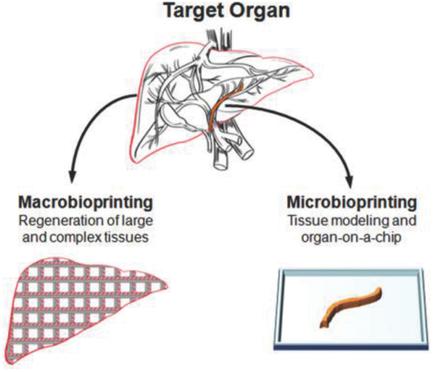当前位置:
X-MOL 学术
›
Small Methods
›
论文详情
Our official English website, www.x-mol.net, welcomes your feedback! (Note: you will need to create a separate account there.)
Micro‐ and Macrobioprinting: Current Trends in Tissue Modeling and Organ Fabrication
Small Methods ( IF 12.4 ) Pub Date : 2018-02-07 , DOI: 10.1002/smtd.201700318 Marco Santoro 1, 2 , Javier Navarro 1, 2 , John P Fisher 1, 2
Small Methods ( IF 12.4 ) Pub Date : 2018-02-07 , DOI: 10.1002/smtd.201700318 Marco Santoro 1, 2 , Javier Navarro 1, 2 , John P Fisher 1, 2
Affiliation

|
The recapitulation of human anatomy and physiology is critical for organ regeneration. Due to this fundamental requirement, bioprinting holds great promise in tissue engineering and regenerative medicine due to the possibility of fabricating complex scaffolds that host cells and biochemical cues in a physiologically relevant fashion. The ever‐growing research in this field has been proceeding along two different, yet complementary, routes: on the one hand, the development of bioprinting to fabricate large tissue surrogates for transplantation purposes in vivo (macrobioprinting), and on the other the spread of bioprinting‐based miniaturized systems to model the tissue microenvironment in vitro (microbioprinting). The latest advances in both macro‐ and microbioprinting are reviewed, emphasizing their impact on specific areas of tissue engineering. Additionally, a critical comparison of macro‐ versus microbioprinting is presented together with advantages and limitations of each approach. Ultimately, findings obtained both at the macro‐ and microscale are expected to provide a deeper insight in tissue biology and offer clinically relevant solutions for organ regeneration.
中文翻译:

微观和宏观生物打印:组织建模和器官制造的当前趋势
人体解剖学和生理学的概括对于器官再生至关重要。由于这一基本要求,生物打印在组织工程和再生医学领域具有广阔的前景,因为它可以以生理相关的方式制造承载细胞和生化线索的复杂支架。该领域不断发展的研究一直沿着两条不同但互补的路线进行:一方面,开发生物打印技术来制造用于体内移植目的的大型组织替代物(宏观生物打印),另一方面,生物打印技术的发展基于生物打印的微型系统,用于模拟体外组织微环境(微生物打印)。回顾了宏观和微生物打印的最新进展,强调了它们对组织工程特定领域的影响。此外,还对宏观生物打印与微生物打印进行了关键比较,以及每种方法的优点和局限性。最终,在宏观和微观尺度上获得的研究结果有望为组织生物学提供更深入的见解,并为器官再生提供临床相关的解决方案。
更新日期:2018-02-07
中文翻译:

微观和宏观生物打印:组织建模和器官制造的当前趋势
人体解剖学和生理学的概括对于器官再生至关重要。由于这一基本要求,生物打印在组织工程和再生医学领域具有广阔的前景,因为它可以以生理相关的方式制造承载细胞和生化线索的复杂支架。该领域不断发展的研究一直沿着两条不同但互补的路线进行:一方面,开发生物打印技术来制造用于体内移植目的的大型组织替代物(宏观生物打印),另一方面,生物打印技术的发展基于生物打印的微型系统,用于模拟体外组织微环境(微生物打印)。回顾了宏观和微生物打印的最新进展,强调了它们对组织工程特定领域的影响。此外,还对宏观生物打印与微生物打印进行了关键比较,以及每种方法的优点和局限性。最终,在宏观和微观尺度上获得的研究结果有望为组织生物学提供更深入的见解,并为器官再生提供临床相关的解决方案。



























 京公网安备 11010802027423号
京公网安备 11010802027423号